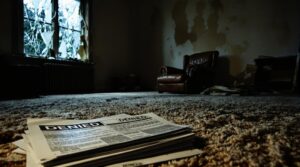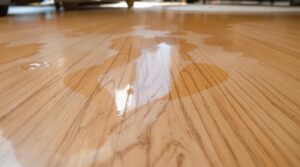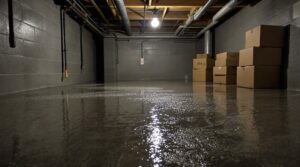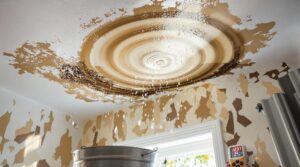Detecting water leaks under concrete floors requires specialized equipment and systematic investigation. Initial signs include unexplained water bill increases, continuous water meter movement, and warm spots on flooring. Professional detection methods utilize thermal imaging cameras, acoustic equipment, moisture meters, and ground-penetrating radar to precisely locate leaks. Public adjusters document findings thoroughly for insurance claims, often securing settlements up to 500% higher. Understanding the thorough detection process guarantees ideal outcomes for both repair planning and claim settlements.
Key Takeaways
- Listen for continuous hissing sounds and watch for unexplained increases in water bills or movement of the water meter when inactive.
- Use thermal imaging cameras to detect temperature variations and identify warm spots on flooring indicating potential leaks.
- Check for visible signs like mold growth, musty odors, warped floors, or compromised door functionality near the affected area.
- Employ moisture meters to measure elevated water content levels in concrete and surrounding areas.
- Perform pressure tests by shutting off the main water valve and monitoring meter movement to confirm leak presence.
Common Signs of Under-Concrete Water Leaks
When homeowners suspect a water leak beneath their concrete floor, several telltale indicators can confirm their suspicions. Effective leak detection begins with monitoring water usage patterns, particularly unexplained increases in water bills or continuous movement of the water meter when pipes aren't active.
A thorough moisture assessment reveals physical evidence including warm spots on flooring, indicating hot water line breaches, and audible sounds of running water during periods of inactivity. Early detection through pressure drop monitoring can help prevent extensive damage to the property.
Structural manifestations often present as warped or buckling floors, foundation settling, and compromised door functionality.
Environmental indicators encompass mold growth, persistent musty odors, and dampness around baseboards. These signs may appear individually or in combination, with severity varying based on leak duration and intensity.
Professional evaluation is recommended when multiple indicators are present.
Essential Tools for Detecting Hidden Water Leaks
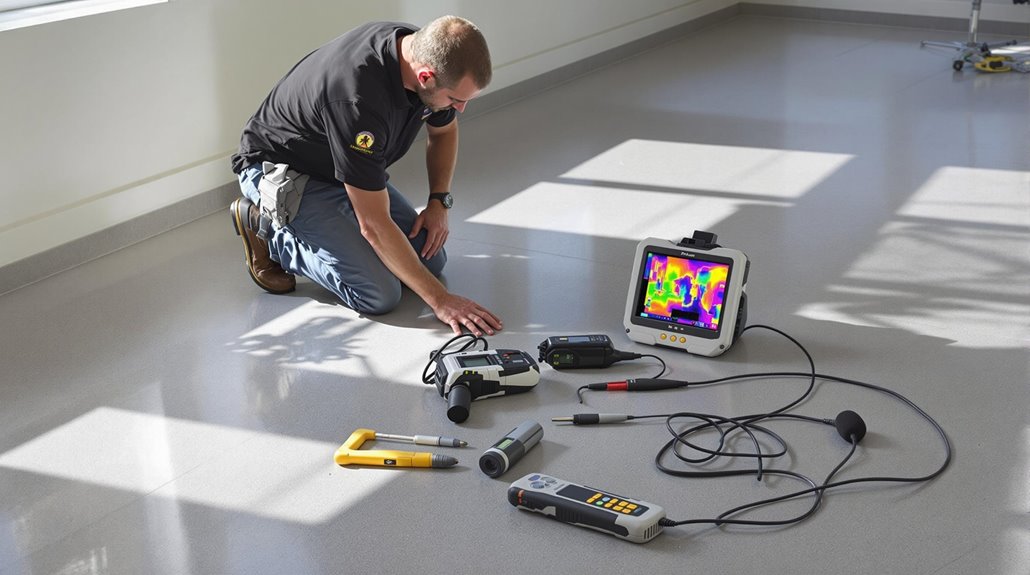
Professional leak detection requires specialized tools designed to identify and precisely locate water leaks beneath concrete floors. Thermal imaging cameras and infrared devices detect temperature variations caused by subsurface moisture, while acoustic detection equipment utilizes sensitive microphones to capture the sound frequencies of escaping water. Advanced moisture meters provide quantitative measurements of water content in building materials. Regular inspection using these tools helps identify issues through signs of water damage before they become severe.
| Detection Method | Primary Function | Application |
|---|---|---|
| Thermal Imaging | Temperature Analysis | Hidden Moisture |
| Acoustic Detection | Sound Wave Analysis | Pipe Leakage |
| Moisture Meters | Water Content Reading | Material Saturation |
These diagnostic tools, when used in combination with tracer gas systems and ground-penetrating radar, enable technicians to accurately pinpoint leak locations without destructive exploration. The integration of these technologies guarantees thorough leak detection through concrete substrates, minimizing structural damage during the investigation process.
Professional Methods to Pinpoint Leak Locations

The systematic detection of subsurface water leaks requires a multi-faceted approach utilizing advanced diagnostic technologies and methodical investigation procedures. Continuous low hissing sounds often indicate water escaping from pressurized pipes beneath concrete floors. In addition to auditory cues, visual signs such as water stains or damp spots on ceilings and walls can also signal the presence of a leak. Homeowners and professionals alike must familiarize themselves with how to identify a leaking pipe to effectively mitigate water damage. By employing a combination of leak detection methods, including moisture meters and thermal imaging, they can pinpoint the source of the problem and take corrective action promptly.
Professional technicians employ thermal imaging cameras, such as FLIR E8 and T-series models, to identify temperature variations indicative of water infiltration beneath concrete surfaces. These specialists complement thermal analysis with acoustic detection methods, utilizing specialized equipment like LeakTronics' DeckPlate and Pipe Probe to locate specific points of water escape.
The thorough inspection process incorporates ground-penetrating radar technology and video camera systems for precise leak identification.
Technicians conduct thorough examinations of the plumbing infrastructure, monitoring water meters and investigating exposed pipes while documenting any structural anomalies.
This integrated methodology enables professionals to pinpoint leak locations with minimal invasive intervention, facilitating targeted repairs and preventing extensive structural damage.
Steps to Confirm and Document a Concrete Floor Leak
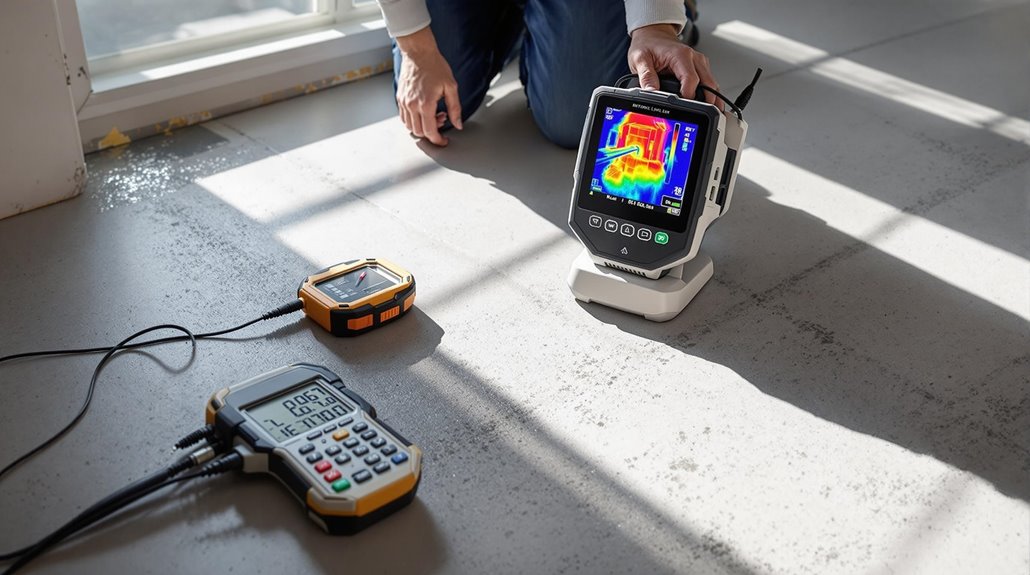
Several systematic steps must be undertaken to confirm and document a concrete floor leak, beginning with a thorough visual assessment of the affected area.
During leak detection, technicians employ moisture meters to measure elevated moisture levels and conduct pressure tests by shutting off the main water valve to monitor pressure drops.
Documentation methods include creating detailed photographic evidence of wet spots, discoloration, and structural damage. Technicians record precise measurements from water meter readings and map the affected zones.
Using specialized equipment such as thermal imaging cameras and listening devices, they detect temperature variations and sound waves that indicate leak locations.
All findings, including moisture readings, pressure test results, and observed anomalies, are systematically logged to establish a detailed record for repair planning and potential insurance claims.
Preventive Measures and Long-Term Solutions
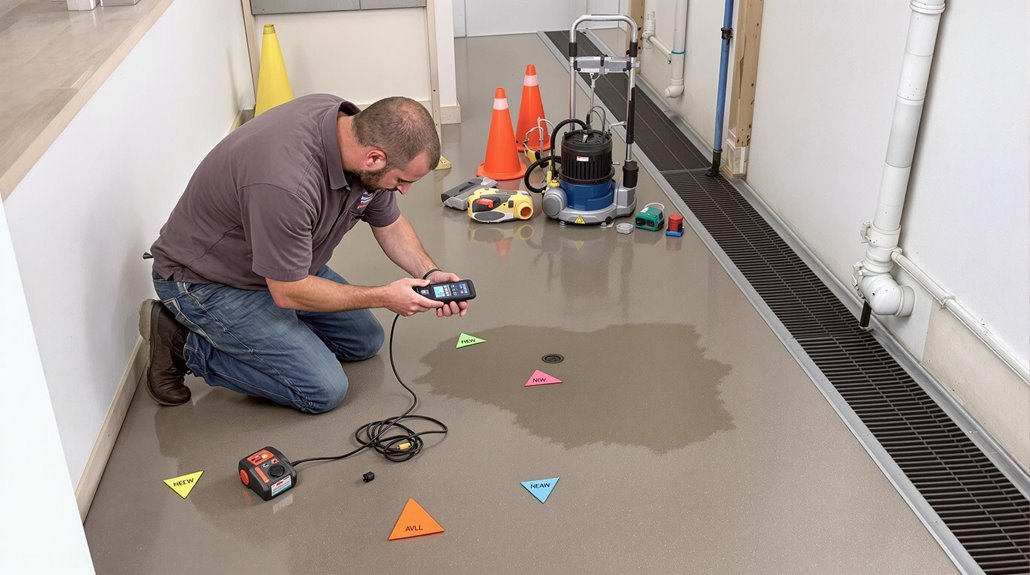
Once a leak has been identified and documented, implementing thorough preventive measures becomes necessary to protect concrete floors from future water damage.
Effective preventive maintenance includes installing French drains and extending gutters to direct water away from foundations. Property grading and regular gutter cleaning further enhance drainage management.
Foundation protection requires systematic leak detection protocols, including sealing cracks with polyurethane foams or epoxies and installing vapor barriers.
A detailed drain tile system, combined with properly wrapped pipes, helps prevent water intrusion. For long-term solutions, professionals may implement trenchless repair methods or tunneling techniques to access damaged lines.
Installing sump pumps provides additional protection by ejecting collected water. Regular monitoring of water bills and inspection for damp spots or warm areas guarantees early detection of potential issues.
The Benefits Of Consulting A Public Adjuster
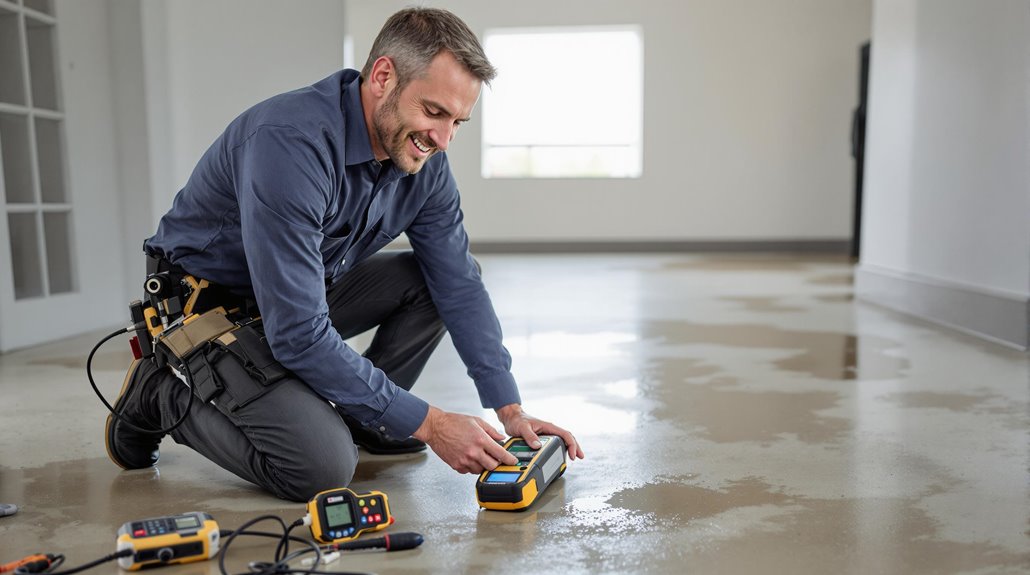
When dealing with water leaks beneath concrete floors, public adjusters provide invaluable expertise in maneuvering complex insurance claims while ensuring proper documentation of structural damage and associated losses.
These licensed professionals conduct thorough, objective assessments of water damage and maintain detailed documentation throughout the claim process, which often results in more extensive settlement outcomes compared to self-filed claims.
Public adjusters streamline the entire claims procedure by managing all communications with insurance carriers, coordinating necessary inspections, and leveraging their industry knowledge to maximize claim settlements for affected property owners.
Studies indicate that engaging public adjuster services can lead to settlement increases of up to 500% for non-catastrophic water damage claims.
Expertise In Insurance Claims
Insurance claims for water leaks under concrete floors present complex challenges that benefit greatly from a public adjuster's expertise. These professionals possess extensive knowledge of insurance procedures and intricate claim strategies that maximize settlement potential. Their proficiency encompasses policy interpretation, coverage analysis, and thorough understanding of claims processing protocols.
Public adjusters meticulously document water damage evidence, prepare detailed assessments, and present thorough claims to insurance carriers. Their expertise enables them to navigate complex policy provisions, identify covered perils, and challenge potential claim denials effectively.
Through strategic negotiation and detailed knowledge of industry practices, they advocate for fair compensation while managing documentation requirements. This specialized knowledge proves particularly valuable when dealing with subsurface water damage, where proper claim presentation greatly impacts settlement outcomes.
Working on a contingency fee basis, public adjusters typically charge between 5-20% of the final settlement amount, making their services accessible to most property owners.
Objective Damage Assessment
Professional public adjusters deliver thorough damage assessments that establish an objective foundation for water leak claims under concrete floors.
Through advanced leak detection methods and specialized equipment, including moisture meters and thermal imaging technology, adjusters conduct extensive evaluations to identify both visible and concealed water damage.
The damage evaluation process encompasses detailed documentation through photographs, videos, and written reports. Public adjusters employ their expertise to uncover underlying issues such as structural deterioration and mold growth that may not be immediately apparent.
This systematic approach guarantees accurate claim preparation and maintains compliance with insurance policy requirements. Their independent assessment provides an unbiased representation of damages, facilitating effective negotiations with insurance companies and supporting fair claim resolution for property owners.
With an average annual salary of claims adjuster earnings around $61,465, these professionals maintain high standards through ongoing education and licensing requirements to ensure accurate damage assessments.
Streamlined Claim Process
Partnering with a public adjuster transforms the often complex water damage claims process into a streamlined, efficient operation. Through professional expertise, adjusters implement systematic procedures for efficient documentation and streamlined communication with insurance providers, ensuring extensive claim management.
| Process Component | Adjuster Action | Benefit |
|---|---|---|
| Documentation | Expert assessment | Accurate damage records |
| Communication | Centralized contact | Reduced response time |
| Settlement | Active negotiation | Maximized compensation |
The adjuster's methodical approach encompasses thorough damage documentation, strategic negotiation tactics, and precise policy interpretation. This systematic process accelerates claim resolution while maintaining regulatory compliance and technical accuracy. By managing all aspects of the claim, from initial assessment through final settlement, public adjusters facilitate expedited processing while allowing property owners to focus on restoration efforts. Unlike insurance adjusters who serve company interests, public adjuster advocacy consistently leads to higher settlement amounts by identifying hidden damages and maximizing claim value.
Higher Claim Payouts & Settlements
When facing substantial water damage beneath concrete floors, engaging a public adjuster demonstrably increases claim settlements through systematic documentation and expert negotiation strategies.
Statistical evidence from the Florida Association of Public Insurance Adjusters indicates markedly higher average payouts with professional representation ($22,266) versus unassisted claims ($18,659).
Public adjusters enhance settlement outcomes through meticulous damage assessment protocols, thorough documentation procedures, and advanced claim negotiation techniques.
Their independent status enables objective evaluation of damages while leveraging industry expertise to counteract potential claim minimization by insurance carriers.
Operating on a contingency basis, these professionals implement strategic settlement strategies focused on identifying all covered damages, ensuring proper valuation, and presenting compelling evidence to support maximum eligible compensation under the policy terms.
With fees ranging from 5% to 15% of the total settlement, public adjusters deliver value by securing substantially higher payouts that typically offset their commission costs.
About The Public Claims Adjusters Network (PCAN)
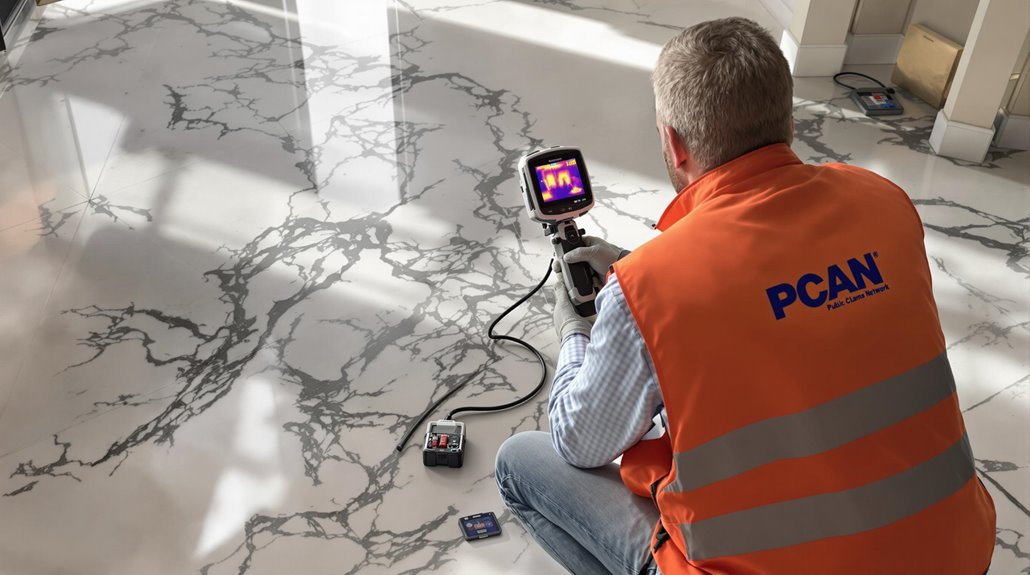
The Public Claims Adjusters Network (PCAN) operates as a thorough claims management organization, leveraging over 40 years of industry expertise to facilitate ideal insurance claim outcomes.
This extensive adjuster network maintains specialized divisions for both routine and catastrophic claims processing, offering seamless support from initial notice through final settlement.
PCAN's infrastructure includes a dedicated call center for immediate first notice of loss handling and status updates, ensuring continuous communication throughout the claims process.
Their network of seasoned public claims adjusters implements customized solutions for complex operational challenges while adhering to rigorous industry standards.
The organization's proven track record is evidenced through client testimonials highlighting their professional approach and technical proficiency in claims management, particularly in maneuvering intricate insurance claim scenarios.
Frequently Asked Questions
How Much Does It Typically Cost to Repair a Leak Under Concrete?
Leak repair costs under concrete floors typically range from $630 to $4,400, with national averages of $2,280-$2,290. Complex repairs requiring slab penetration or extensive plumbing modifications increase expenditures considerably.
Can I Continue Living in My Home During Leak Detection Repairs?
Residential occupancy during repairs depends on contamination levels and repair scope. Living arrangements may require temporary accommodations if water damage presents health risks or significant disruption to daily operations.
Will My Homeowner's Insurance Cover Water Leak Detection and Repairs?
Standard homeowners insurance typically covers water damage from sudden, accidental leaks, but excludes gradual deterioration. Insurance claims for detection services may require additional coverage or specialized endorsements for thorough protection.
How Long Does a Complete Leak Detection and Repair Process Take?
While plumbers dream of instant fixes, professional leak detection typically takes 1-2 days, followed by repair techniques spanning 3-14 days, depending on damage severity and restoration complexity.
Are There DIY Methods to Fix Small Leaks Under Concrete Floors?
DIY leak detection methods include pressure testing and thermal imaging, while repair techniques involve applying crack repair kits, epoxy injections, or moisture vapor barriers for minor concrete floor leaks.
References
- https://www.leakhero.com/how-to-find-a-water-leak-under-a-concrete-floor/
- https://www.aztecplumbing.net/blog/how-to-find-a-water-leak-under-concrete/
- https://leakdetection.co.uk/tips/water-leak-in-concrete-floor/
- https://theleakdetective.co.uk/uncategorized/how-to-find-a-water-leak-under-concrete/
- https://www.mrrooter.ca/about/blog/2021/september/how-to-detect-a-leak-under-a-concrete-floor/
- https://www.accurateleak.com/blog/7-signs-of-plumbing-leaks-below-the-foundation/
- https://www.rootermantx.com/blog/how-to-detect-a-water-leak-under-a-foundation-slab/
- https://www.barkerandsonsplumbing.com/slab-leak-faqs/
- https://drainmagic.com/10-ingenious-ways-to-detect-hidden-water-leaks/
- https://www.inficon.com/en/news/water-leak-detection
